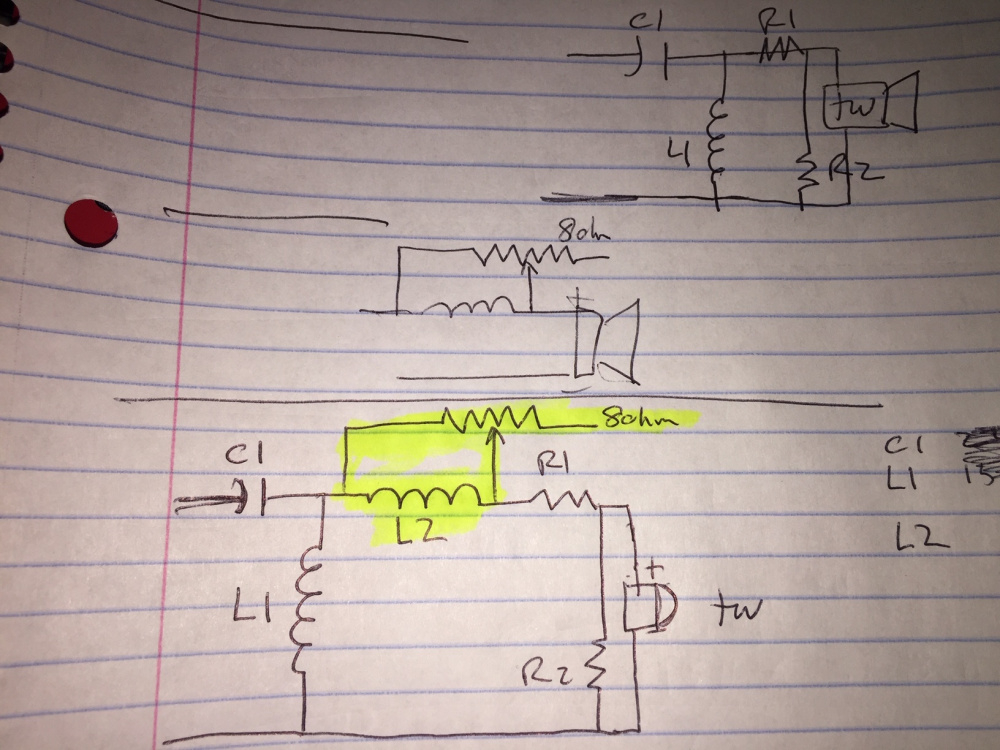Site Links
Howdy, Stranger!
It looks like you're new here. If you want to get involved, click one of these buttons!
Quick Links
Categories
In this Discussion
Who's Online (0)
circuit design issue / question
I’m considering adding a circuit to address a slight upward tilt of a tweeter by using a varying resistor (1/2 Lpad set-up) across a small inductor (as sometimes used with full range drivers) in the HP filter section of a two-way (the yellow section in the attached pic.).
I understand Lpads have more generally been used to adjust the (entire) level of the tweeter in relation to the mid (or woofer) i.e. JBLs. However (even while keeping the load consistent) adjusting upward or downward the tweeter level in this fashion upsets the HP filter relationship to the LP filter (moving the whole tweeter curve up or down, creating a void or hump across this crossover range).
In comparison, implementing a varying resistor across an inductor can be designed to vary the tweeter’s tilt (from a targeted frequency point) with less or nominal impact on the HP / LP relationship.
My question is will this set-up, which places an inductor in ~series with a capacitor (C1 relative to L2, be problematic? And/or does the inductor L1 in parallel (dropping between the cap and coil) relieve this issue? Or is this a non-issue? I’d like to put this into passive crossover designer to confirm, but running 'parallels' on my older MAC wasn’t all that successful.
Thanks. 

Comments
The impact of the R-L circuit has on the remainder of the crossover (C1/L1) is hard to estimate without throwing it in a simulation. But I would think that if the R-L frequency is far enough away (e.g.10 KHz) from the crossover frequency (e.g. 2 KHz) it shouldn't have a major effect. That's just a seat of the pants guess though.
Thx for all the input !
I'm playing with the +'s and -'s of having an adjustable tweeter level, and find a tilt adjustment more valid than the 'std' Lpad on the tweeter (which as mentioned above negatively affects the crossover frequency zone response).
I bi-amp and use active crossover DSP between the woofers and the mid/tw, and passive components for the mid/tw crossover. And as such I can set the tweeter response with a slight hot tilt so that in using the L-R contour (thx Ed) I can hone in / tune, via the adjustable L-R, where it sounds best in my listening room, and as measured off axis. And John I think it was you whom suggested setting/measuring Xover at 15 degrees off axis, which is now part of my process- thx.
jhollander
I had worked out a 3rd order HP for the tweeter (with the two resistor attenuation circuit), to a good point.
However, per your recommendation I'm dumping the RL idea, and have a quesiton of dumping R2 (having a single series resistor?)
Not having access to a full crossover software designer (just the calculators), I’d appreciate your thoughts on the value of a series resistor (as a staring point), and best location within the HP filter for the series resistor. I.e. upstream from the filter. Or possibly downstream from the filter, and as such making an adjustment to the tweeter’s resistance value (the tweeter + the R) in the calculator?.
The beyma mid sensitivity is stated to be 92.5 dB and the tweeter at 102dB (both rated 1w / 1m).
thanks
THX, Hope to limit your efforts (which I certainly appreciate) to how to best set the series resistor value (to deal with sensitivity diff of drivers), and location in the filter chain.
https://www.beyma.com/speakers/Fichas_Tecnicas/beyma-altavoces-hoja-tecnica-coaxial-5CX200NdN.pdf
Thanks just doesn't seem to do it.
so a 2nd order HP, where if you don't mind me asking would you expect the Xover freq?
THX
what would targeting 5.4K Xover look like (values)? I've had a preference, if the driver(s) can work (I measure the off axis roll) for getting the Xover just out of the 1-5KHz (highest hearing sensitivity range)
And you may have nailed it on the 3.8K, looking at the fall off of the mid driver...
While the XSim does appear shifted downward ~2800 Hz from the co’s sheet, 3.8K looks to be a really good Xover target (and great advice to dump the RL on this)
THX